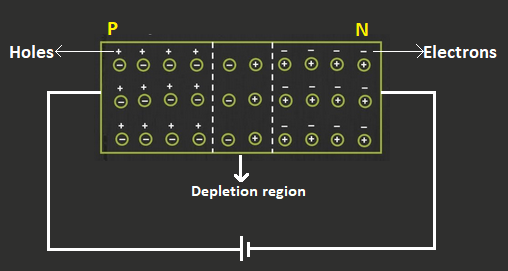
An LED operates under which biasing condition?
A. Forward bias
B. Reverse bias
C. Can operate both in forward and reverse bias
D. No biasing is required
Answer
567.3k+ views
Hint: We are asked to find which biasing condition LED works. We know that LED is a source of light that is based on a simple p-n junction diode. When we pass current through an LED the holes and the electrons combine together and emit light. To find the condition of bias in an LED we need to know about the bias in the p-n junction.
Complete step by step answer:
We know that LED or light emitting diodes is a light source that is based on semiconductors.
We also know that LED is a simple p-n junction diode.
In the case of a p-n junction diode, we know that it only allows the flow of current in the forward direction and also restricts the flow of current in the reverse direction.
Therefore a p-n junction diode works under the forward bias condition.
Since LED or light emitting diode is a p-n junction diode, we can say that LED operates under forward bias.
Hence the correct answer is option A.
Note:

The above figure shows us a p-n junction diode.
The p-n junction diode is a combination of p-type semiconductor and a n-type semiconductor.
Hence it has a p- side, a n-side and a depletion region.
Majority charge carriers on the p-side are holes and on the n- side are electrons.
The p-n junction diode allows the flow of current only in one direction and also does not allow the current flow in reverse direction.
We can also say that a p-n junction diode allows only forward bias and restricts reverse bias.
During the forward bias condition, the holes in the p-side will move from p-side to the n-side and the electrons in the n-side will move from n-side to p-side.
At the junction boundaries, concentration of minority charge carriers increases, i.e. at the p-junction the concentration of electrons increases and at the n-junction concentration of holes increases.
Hence this minority charge carrier combines with the majority charge carriers and produces photons and thus emits light.
Complete step by step answer:
We know that LED or light emitting diodes is a light source that is based on semiconductors.
We also know that LED is a simple p-n junction diode.
In the case of a p-n junction diode, we know that it only allows the flow of current in the forward direction and also restricts the flow of current in the reverse direction.
Therefore a p-n junction diode works under the forward bias condition.
Since LED or light emitting diode is a p-n junction diode, we can say that LED operates under forward bias.
Hence the correct answer is option A.
Note:

The above figure shows us a p-n junction diode.
The p-n junction diode is a combination of p-type semiconductor and a n-type semiconductor.
Hence it has a p- side, a n-side and a depletion region.
Majority charge carriers on the p-side are holes and on the n- side are electrons.
The p-n junction diode allows the flow of current only in one direction and also does not allow the current flow in reverse direction.
We can also say that a p-n junction diode allows only forward bias and restricts reverse bias.
During the forward bias condition, the holes in the p-side will move from p-side to the n-side and the electrons in the n-side will move from n-side to p-side.
At the junction boundaries, concentration of minority charge carriers increases, i.e. at the p-junction the concentration of electrons increases and at the n-junction concentration of holes increases.
Hence this minority charge carrier combines with the majority charge carriers and produces photons and thus emits light.
Recently Updated Pages
A man running at a speed 5 ms is viewed in the side class 12 physics CBSE

The number of solutions in x in 02pi for which sqrt class 12 maths CBSE

State and explain Hardy Weinbergs Principle class 12 biology CBSE

Write any two methods of preparation of phenol Give class 12 chemistry CBSE

Which of the following statements is wrong a Amnion class 12 biology CBSE

Differentiate between action potential and resting class 12 biology CBSE

Trending doubts
What are the major means of transport Explain each class 12 social science CBSE

Which are the Top 10 Largest Countries of the World?

Draw a labelled sketch of the human eye class 12 physics CBSE

Explain sex determination in humans with line diag class 12 biology CBSE

Explain sex determination in humans with the help of class 12 biology CBSE

Differentiate between homogeneous and heterogeneous class 12 chemistry CBSE




